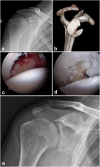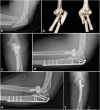Shoulder and Elbow Fractures in Athletes
- PMID: 30706285
- PMCID: PMC6388575
- DOI: 10.1007/s12178-019-09530-0
Shoulder and Elbow Fractures in Athletes
Abstract
Purpose of review: The purposes of this review are to discuss the management of shoulder and elbow fractures in athletes to optimize the return to sport and to highlight treatment impact on the return to play.
Recent findings: Fractures of the shoulder and elbow can have profound implications in an athlete career. Recent technique of fractures management trended toward to preserve soft tissue which is critical for an early recovery in athletic population. Arthroscopy presents a strong interest for the treatment of intra-articular fracture, and minimally invasive approach as developed in humeral shaft fracture can be considered to avoid soft tissue damage. Non-articular, stable, and minimally displaced fractures are mainly treated conservatively. However, we encourage a more aggressive approach in shoulder and elbow injuries in the athletes including minimally invasive and stable fixation to preserve vascularity and muscle environment.
Keywords: Athlete fracture; Clavicle fracture; Glenoid fracture; Mid-shaft humeral fracture; Scapula fracture.
Conflict of interest statement
Conflict of Interest
Marion Burnier and Jon D. Barlow declare no conflict of interest.
Joaquin Sanchez-Sotelo is a consultant for Stryker.
Human and Animal Rights and Informed Consent
This article does not contain any studies with human or animal subjects performed by any of the authors.
Figures




Similar articles
-
[Arthroscopically Assisted Minimally Invasive Fixation of a Type D2c Scapular Fracture].Z Orthop Unfall. 2018 Aug;156(4):443-448. doi: 10.1055/a-0576-2036. Epub 2018 Jun 12. Z Orthop Unfall. 2018. PMID: 29895090 German.
-
Operative treatment of torsional humeral shaft fractures in throwers leads to an earlier return to sport: a survey of expert shoulder and elbow surgeons.Knee Surg Sports Traumatol Arthrosc. 2019 Dec;27(12):4049-4054. doi: 10.1007/s00167-019-05733-7. Epub 2019 Oct 14. Knee Surg Sports Traumatol Arthrosc. 2019. PMID: 31612264
-
Minimally Invasive Double-Button Fixation of Displaced Lateral Clavicular Fractures in Athletes.Am J Sports Med. 2017 Feb;45(2):462-467. doi: 10.1177/0363546516666816. Epub 2016 Oct 7. Am J Sports Med. 2017. PMID: 28146404
-
Carpal fractures in athletes.Clin Sports Med. 2001 Jan;20(1):167-88. doi: 10.1016/s0278-5919(05)70254-4. Clin Sports Med. 2001. PMID: 11227704 Review.
-
[Reduction techniques for minimally invasive stabilization of proximal humeral fractures].Oper Orthop Traumatol. 2019 Feb;31(1):63-80. doi: 10.1007/s00064-018-0586-0. Epub 2019 Jan 25. Oper Orthop Traumatol. 2019. PMID: 30683977 Review. German.
Cited by
-
A Review of Workload-Monitoring Considerations for Baseball Pitchers.J Athl Train. 2020 Sep 1;55(9):911-917. doi: 10.4085/1062-6050-0511-19. J Athl Train. 2020. PMID: 32991703 Free PMC article. Review.
-
Pediatric Clavicle Fractures and Congenital Pseudarthrosis Unraveled.Children (Basel). 2022 Jan 3;9(1):49. doi: 10.3390/children9010049. Children (Basel). 2022. PMID: 35053674 Free PMC article. Review.
-
Fracture Epidemiology in Professional Baseball From 2011 to 2017.Orthop J Sports Med. 2020 Aug 14;8(8):2325967120943161. doi: 10.1177/2325967120943161. eCollection 2020 Aug. Orthop J Sports Med. 2020. PMID: 32923499 Free PMC article.
References
-
- Conte S, Camp CL, Dines JS. Injury trends in major league baseball over 18 seasons: 1998–2015. Am J Orthop (Belle Mead NJ) 2016;45(3):116–123. - PubMed
Publication types
LinkOut - more resources
Full Text Sources
Research Materials

